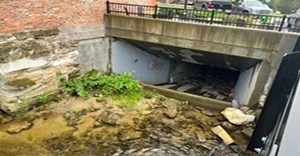Vermont avoids flooding disaster with new culvert, FEMA reports
(UI) – In Brandon, Vermont, catastrophic floods have hit the town’s residents from the time of its founding – until they used FEMA funding after Tropical Storm Irene to build a $2.5 million culvert. This July, when severe storms rolled across Vermont, that decision proved its worth: downtown didn’t flood.
Brandon has a distinct hydrological feature nestled in its downtown: the Neshobe River becomes a waterfall.
Neshobe Falls drops over twenty-five feet onto a rocky outcrop, then continues underneath scenic U.S. Route Seven, known locally as Center Street.
The river has been one of Brandon’s major attractions since it was chartered in 1761. In the 1820s, residents harnessed the river to generate hydropower for the mills downtown. They built a low dam upstream – creating the falls – and installed a canal that twisted the river almost 90 degrees. This turn produced a swifter flow, which increased the hydropower the river created – but also increased flooding.
The Neshobe flooded again and again: in 1869, 1927, 1938, 1947 and 1973. When Tropical Storm Irene struck in 2011, it carved a swath through downtown Brandon that almost exactly mirrored its destruction in 1938.
With downtown businesses shuttered, residents rallied to rebuild. Ethan Swift, a former elected member of the town selectboard and longtime employee of Vermont’s Department of Environmental Conservation, proposed building a culvert. If they could give the overflow somewhere to go, it wouldn’t keep overwhelming the bottleneck at the falls.
After an informational campaign, including videos and public meetings, the town was onboard.
Town management and the state of Vermont coordinated with FEMA’s Hazard Mitigation Grant Program to plan and fund the massive effort.
The project was completed in several stages. First, the House of Pizza, a restaurant that the Neshobe pushed onto the sidewalk of Center Street, was demolished. Most of the adjacent business’ rear dining area was removed, and two pillars were installed for stability: parts of the building still hung over the river.
Then, construction under the street began. Crews excavated into the bedrock, then used cranes to lower pre-formed concrete sections into place.
The resulting culvert now measures six feet high, 12 feet wide and 230 feet long. It remains dry most of the year, but when heavy rain or snow melt inundates the river, it funnels the water safely under Center Street.
Construction ran from October 2016 through May 2017, and finished right on time – according to the schedule, and to nature.
“On the first of July, we received four inches of rain in a couple hours,” said Bill Moore, the former interim town manager. “The culvert accepted water for the first time, and saved downtown from flooding.”
Each time the downtown flooded, repairs would cost an average of $412 thousand. With this project, FEMA covered $1.8 million – 75% of the cost – to install the culvert that averted not only this year’s flood, but, hopefully, many more.
“It’s been life changing,” said the current town manager, Seth Hopkins. “It used to be, when a big storm was predicted, all the business owners would start to think, ‘What do we need to do? Do we need to put sandbags around the backdoor?’”
Now, a group of residents has a new tradition: when the rains ease, they carry folding chairs to a ledge by the culvert and sit and watch the river flow through.
“It’s really just been this massive relief,” said Hopkins.
Related News
From Archive

- Glenfarne Alaska LNG targets late-2026 construction start for 807-mile pipeline project
- U.S. water reuse boom to fuel $47 billion in infrastructure spending through 2035
- $2.3 billion approved to construct 236-mile Texas-to-Gulf gas pipeline
- Major water pipe break in Puerto Rico hits over 165,000 customers
- Potomac River Tunnel project enters construction phase beneath Washington, D.C.
- Pennsylvania American Water launches interactive map to identify, replace lead water service lines
- Trump's tariffs drive $33 million cost increase for Cincinnati sewer project
- Utah city launches historic $70 million tunnel project using box jacking under active rail line
- Tulsa residents warned after sewer lines damaged by boring work
- Fatal trench collapse halts sewer construction in Massachusetts; two workers hospitalized




Comments